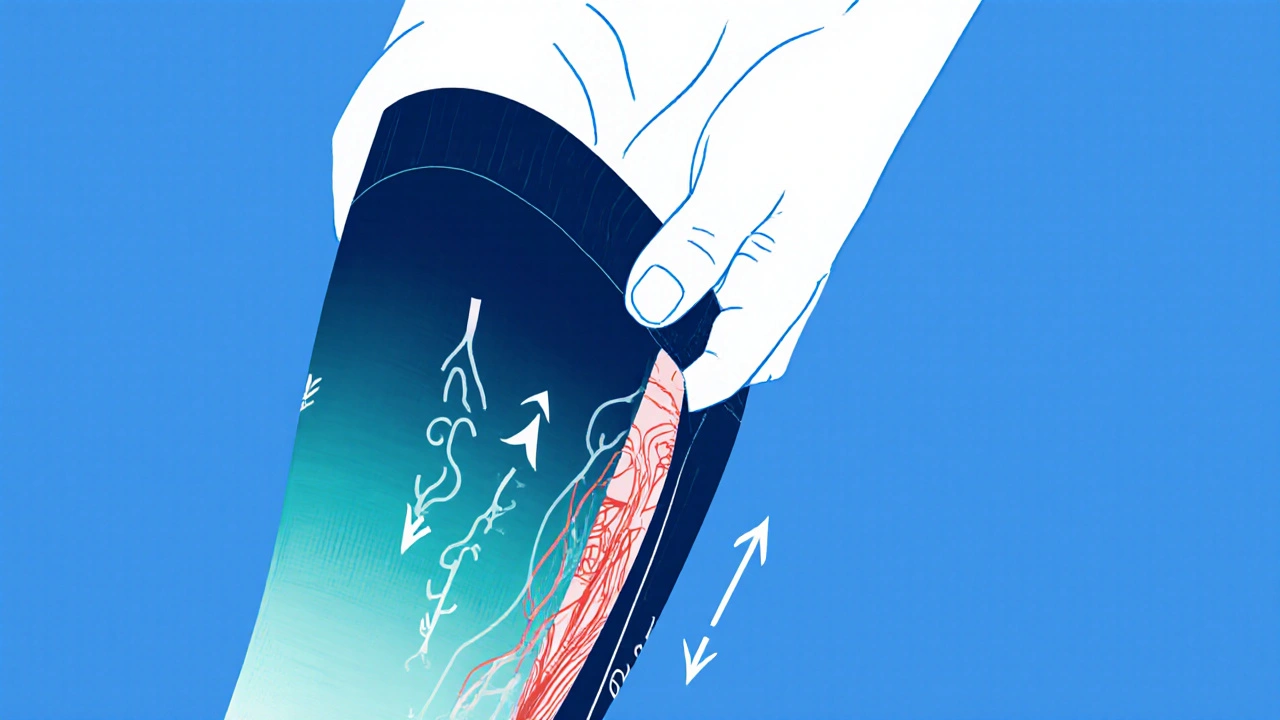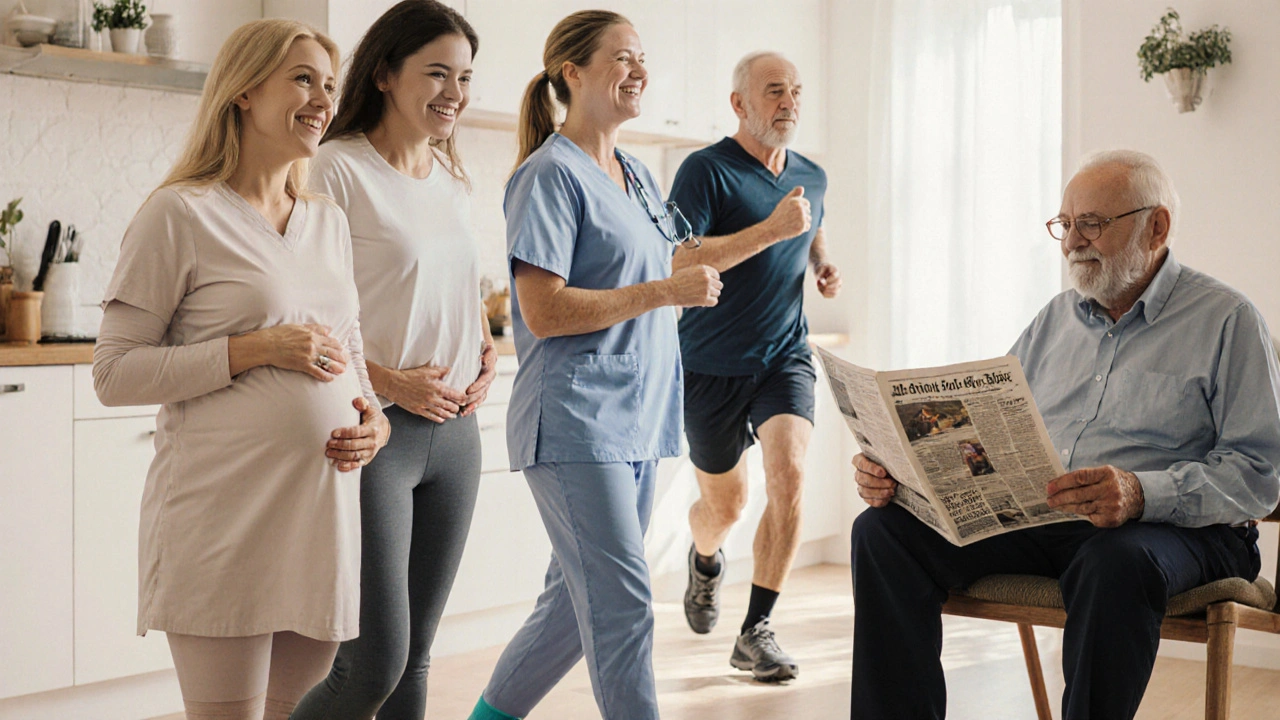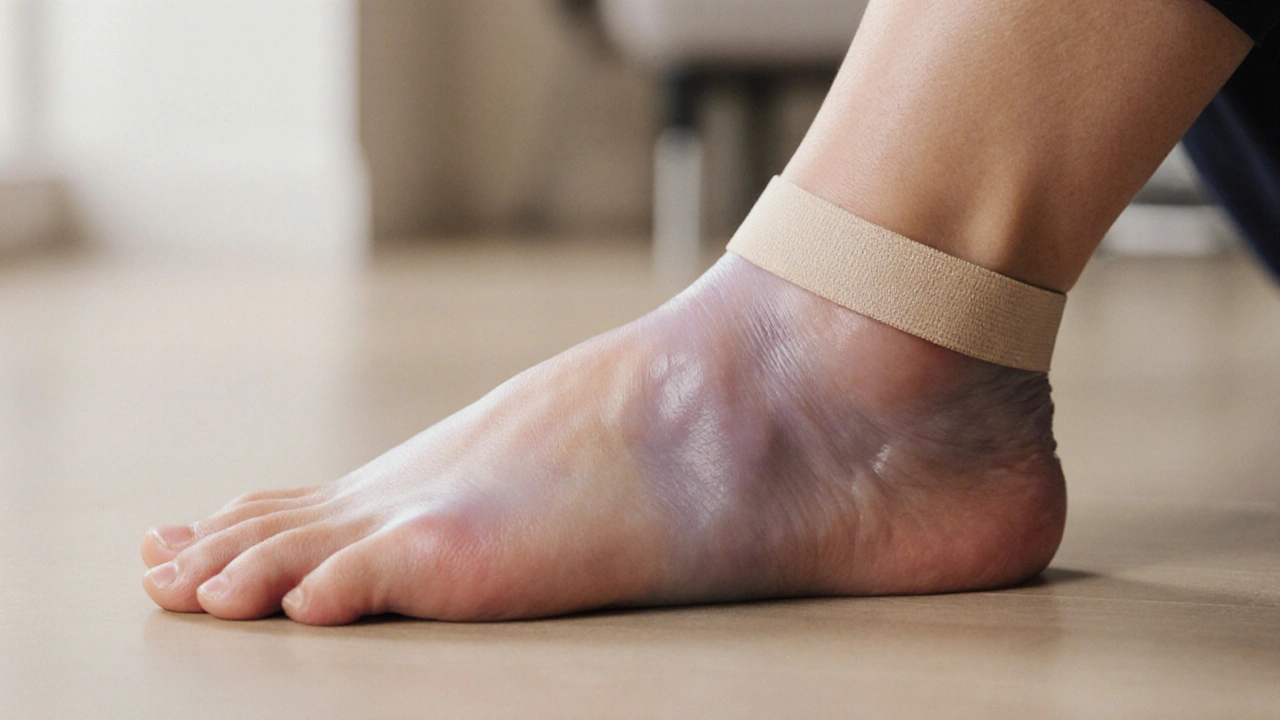Compression Sock Selector
Find Your Ideal Compression Level
Select your condition and symptom severity to determine the recommended compression level for fluid retention.
When fluid builds up in your lower legs, the discomfort can feel like a heavy, tight band that just won’t let go. Compression socks are specially designed hosiery that apply graduated pressure to the foot, ankle, and calf to improve blood flow and push excess fluid back toward the heart have become a go‑to solution for anyone dealing with swelling, whether it’s from standing all day, pregnancy, or a medical condition. That’s why compression socks are worth a closer look.
Key Takeaways
- Graduated pressure moves fluid upward, easing daily leg swelling.
- Even low‑grade (8-15mmHg) socks can help mild fluid retention.
- Proper fit prevents skin irritation and maximizes benefit.
- People with certain circulatory issues should, however, check with a clinician first.
- Choosing the right compression level depends on activity, condition, and doctor advice.
How They Work: The Science Behind the Pressure
Fluid retention refers to the accumulation of excess water in the body’s tissues, often showing up as swelling in the legs or ankles occurs when the veins in the lower limbs struggle to push blood back up against gravity. Venous insufficiency is a common cause where vein valves are weakened, allowing blood to pool creates a pressure gradient that forces fluid out of the blood vessels and into surrounding tissue.
Graduated compression means the sock is tightest at the ankle and gradually loosens toward the knee, mimicking the natural pressure the leg experiences when walking. This external force nudges the stagnant blood upward, re‑engaging the muscle pump that normally helps propel blood during movement. As circulation improves, the lymphatic system can also clear interstitial fluid more efficiently, reducing edema the medical term for swelling caused by excess fluid in tissues.
Direct Benefits for Fluid Retention
1. Reduced ankle and calf swelling - Most users notice a visible decrease within a few hours of wearing the socks, especially after a long day on their feet.
2. Less discomfort and heaviness - The pressure alleviates the feeling of tightness, allowing muscles to relax.
3. Improved performance - Athletes and nurses who stand for hours report quicker recovery and fewer cramp episodes.
4. Support for medical conditions - People with lymphedema a chronic swelling caused by a compromised lymphatic system or a history of deep vein thrombosis (DVT) a blood clot in a deep vein, often of the leg can use them as a non‑pharmaceutical adjunct (always under doctor supervision).

Choosing the Right Compression Level
| Level | Pressure (mmHg) | Typical Use | Pros | Cons |
|---|---|---|---|---|
| Light | 8-15 | General travel, mild swelling | Comfortable, easy to wear all day | May not help moderate edema |
| Moderate | 15-20 | Pregnancy, standing occupations, mild venous insufficiency | Balanced support, noticeable reduction in swelling | Can feel tight for some users |
| Firm | 20-30 | Post‑surgery, diagnosed venous disease, lymphedema | Strong therapeutic effect | Requires precise fitting, may be uncomfortable for long wear |
Start low if you’re new to compression. If swelling persists, move up a level after consulting a health professional. Remember, higher pressure isn’t always better; it just needs to match the underlying cause.
Fit Matters: Getting the Size Right
Measure both the circumference of your ankle and the widest part of your calf, then consult the brand’s size chart. The sock should feel snug but not painfully tight-there should be no indentation marks after removal. If you notice a “pinching” sensation, try the next size up.
Wear them in the morning before swelling starts. If you put them on after a heavy workout, the tissue may already be engorged, making the fit feel overly restrictive. For optimal effect, keep them on for at least 8-10 hours, then gently roll them down before taking them off to protect the skin.
Potential Risks and Contra‑Indications
Most people tolerate compression well, but there are scenarios where caution is needed:
- Severe arterial disease - If blood flow to the leg is already compromised, extra pressure can worsen ischemia.
- Skin infections or open wounds - The tight fabric can trap bacteria and delay healing.
- Allergic reactions - Some fabrics contain latex or synthetic dyes that irritate sensitive skin.
Always get a doctor’s go‑ahead if you have diabetes, peripheral artery disease, or a recent surgery involving the lower limb.

Who Benefits Most?
Pregnant women often develop swelling due to hormonal changes and increased blood volume. Light to moderate compression can keep legs feeling lighter and reduce varicose vein formation.
Professionals on their feet - nurses, teachers, retail staff - typically see a drop in end‑of‑day heaviness when they switch to 15-20mmHg socks.
Athletes use firm compression during recovery to speed up the removal of metabolic waste from muscles, indirectly reducing leg swelling after intense training.
Seniors with mild venous insufficiency or early‑stage lymphedema can maintain mobility and independence by preventing dramatic swelling episodes.
Quick Maintenance Tips
- Hand‑wash in lukewarm water; avoid harsh detergents that break down elastic fibers.
- Air‑dry away from direct heat to keep compression levels intact.
- Replace socks every 3-6 months, or sooner if you notice loss of elasticity.
Frequently Asked Questions
Can I wear compression socks all day?
Yes, most experts recommend 8‑10hours of continuous wear, especially during the periods when swelling is most likely (morning to evening). Take them off at night to let the skin breathe.
Do compression socks help with weight loss?
They don’t burn fat, but by improving circulation they can reduce the feeling of heaviness, making exercise feel easier and encouraging a more active lifestyle.
What’s the difference between stockings and socks?
Stockings typically extend up to the thigh and are used for higher‑grade compression, while socks cover only the foot, ankle, and calf. Choose based on the area you need to treat.
Can I wear them while sleeping?
Generally not recommended unless a physician prescribes night‑time wear for a specific condition, because prolonged pressure without movement can affect circulation.
How do I know which size to buy online?
Measure the circumference of your ankle and the widest part of your calf, then match those numbers to the brand’s sizing chart. If you’re between sizes, opt for the larger one for comfort.

Renee van Baar
Compression socks can be a game‑changer for anyone who spends long hours on their feet, and the key is finding the right fit. Start by measuring both your ankle and the widest part of your calf, then compare those numbers to the brand’s size chart. If the sock feels snug without leaving deep indentations, you’re in the sweet spot. Remember to put them on in the morning before swelling starts – that way the fabric can work its magic all day. For pregnant folks, a light to moderate level (8‑15 mmHg or 15‑20 mmHg) usually does the trick without being uncomfortable.
Take breaks to walk around if you can; the muscle pump works hand‑in‑hand with the compression to push fluid back up.
Mithun Paul
While the article provides a superficial overview, it neglects to address the clinical guidelines established by the American Venous Forum. The recommendation to "start low" lacks citation, and the presentation of compression levels is oversimplified, failing to differentiate between graduated and uniform pressure systems. Moreover, the assertion that “most users notice a visible decrease within a few hours” is anecdotal at best and not corroborated by peer‑reviewed evidence. A more rigorous approach would reference randomized controlled trials and include contraindications beyond a generic list.
Sandy Martin
I totally agree with the emphasis on measuring both the ankle and the calf – it’s crucial for comfort. One tip that many overlook is to double‑check the size after a day of wearing them; swelling can change the fit slightly. Also, if you notice any pinching or red marks, you’re probably wearing the wrong size, so move up a notch. It’s defintely better to err on the side of a little extra room than to restrict circulation.
Keep the socks clean; hand‑wash them in lukewarm water and avoid harsh detergents that could degrade the elastic fibers.
Steve Smilie
Ah, the elegant symphony of pressure gradients! One must appreciate the delicate ballet between elastomeric fibers and hydrostatic forces that culminates in the graceful alleviation of edema. Selecting a compression garment is not merely a utilitarian act but an artistic endeavor, demanding discerning taste and an eye for the subtle hues of therapeutic nuance. Opt for fabrics that whisper against the skin, lest the experience devolve into a cacophony of irritation.
Josie McManus
Yo, that formal critique was over the top – nobody needs a PhD to know compression socks help. Just grab the right size, wear ’em morning to night, and you’ll feel less like you’re walking on bricks. If you’re still sore, maybe you’re just not using enough pressure, not because some article is wrong.
Heather Kennedy
From a biomechanical standpoint, the incorporation of graduated compression aligns with the principles of venous return augmentation. In practice, ensuring a seamless transition from ankle to calf circumferences mitigates shear stress, thereby preserving integumentary integrity. Remember, the tension profile should follow a monotonic decrease proximal to distal, which optimizes the anticoagulant effect of shear stress on endothelial function.
Janice Rodrigiez
When it comes to choosing the proper compression sock, there are several practical steps that can make all the difference. First, take accurate measurements of both your ankle circumference and the widest part of your calf; a tape measure works best. Second, consult the manufacturer’s size chart and select the size that matches those numbers, erring on the side of a slightly larger fit if you’re between sizes. Third, put the socks on first thing in the morning before any swelling has a chance to develop; this allows the fabric to exert its intended pressure throughout the day. Fourth, wear them for at least eight to ten hours, but avoid sleeping in them unless a physician specifically recommends night‑time use. Fifth, monitor how your skin feels; there should be no painful pinching or indentation marks after removal. Sixth, if you notice any discomfort, adjust the size or compression level-sometimes a higher mmHg rating is necessary for more severe edema, but only under medical guidance. Seventh, maintain the socks by hand‑washing in lukewarm water with mild detergent, avoiding fabric softeners that can degrade elasticity. Eighth, air‑dry them away from direct heat sources to preserve the compression integrity. Ninth, replace the socks every three to six months, especially if you detect a loss of snugness. Tenth, be aware of contraindications such as severe arterial disease, open wounds, or skin infections, which require professional evaluation before use. Eleventh, for conditions like lymphedema or chronic venous insufficiency, coordinate with a certified therapist to ensure the appropriate pressure gradient is applied. Finally, keep a log of how your legs feel each day; tracking progress helps you and your healthcare provider gauge effectiveness and adjust treatment as needed.
Roger Cardoso
Honestly, the whole compression‑sock hype is just another distraction while big pharma pushes pricey alternatives. You’re told to buy these fancy garments, but the real solution is something the elites don’t want you to know-proper movement and foot‑grounding practices. Don’t buy into the market‑driven narrative.
barry conpoes
What’s wrong with a little patriotic support for American‑made compression gear? Imported knock‑offs don’t meet the same standards, and buying domestically keeps our jobs strong. If you want quality, look for brands that proudly display "Made in USA" on their packaging.